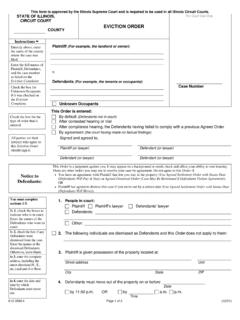Transcription of Act 2004. Housing Health Rating System - GOV.UK
1 Housing Health and Safety Rating System Operating GuidanceODPMThe Housing Health and Safety Rating System is a means ofidentifying faults in dwellings and of evaluating the potentialeffect of any faults on the Health and safety of the operating guidance is issued under S9 of the HousingAct Healthand SafetyRating SystemOperating GuidanceHousing Act 2004 Guidance about inspections and assessment of hazardsgiven under Section 9 ISBN 13: 978 185112 846 4 ISBN 10: 1 85112 846 8 Price: 80858-ODPM- Housing -PFI-Cover 20/2/06 10:11 Page bc4 Housing Health and Safety Rating SystemOperating GuidanceHousing Act 2004 Guidance about inspections and assessment of hazardsgiven under Section 9 February 2006 Office of the Deputy Prime Minister: LondonThe Office of the Deputy Prime MinisterEland HouseBressenden PlaceLondon SW1E 5 DUTelephone: 020 7944 4400 Web site: Crown copyright in the typographical arrangement rests with the publication, excluding logos, may be reproduced free of charge in any format or medium forresearch, private study or for internal circulation within an organisation.
2 This is subject to it beingreproduced accurately and not used in a misleading context. The material must be acknowledged asCrown copyright and the title of the publication any other use of this material, please write to HMSO, St Clements House, 2-16 Colegate, Norwich NR3 1BQ. Fax: 01603 723000 or e-mail: copies of this publication are available from:ODPM PublicationsPO Box 236 WetherbyWest YorkshireLS23 7 NBTel: 0870 1226 236 Fax: 0870 1226 237 Textphone: 0870 120 7405E mail: online via the Office of the Deputy Prime Minister s web in Great Britain on material containing no less than 75% post-consumer 200605 HMD 03485/AISBN 13: 978 185112 846 4 ISBN 10: 1 85112 846 8 CONTENTSARRANGEMENT OF THE GUIDANCE5 CHAPTER 17 Introduction and Background7 The Background to the Housing Health & Safety Rating System8 The Theory Behind the HHSRS8 The Principle Underlying the HHSRS8 CHAPTER 210 Terminology, and Extent and Purpose of the Guidance10 Glossary10 Deficiency10 Dwelling10 Element11 Harm and Class of Harm11 Hazard11 Hazard Score and Rating11 Health12 HHSRS Formula12 Ideal12 Likelihood12 Location12 Occurrence12 Representative Scale Points12 Risk13 Spread of Harms13 Vulnerable Group13 Responsibility for Deficiencies and Hazards13 Landlords Responsibilities14 CHAPTER 315 Overview of Rating Hazards15 The HHSRS Formula16 Judging the Likelihood17 Judging the Spread of Harm outcomes20 Generating a Hazard Score22 The Hazard Bands23 CHAPTER 424 The Assessment of Conditions Using the HHSRS 24 The Inspection Procedure24 Assessing the Condition24 Linking Deficiencies and Hazards24 Identifying Hazards26 Assessing Hazards27 Options for Calculating the Hazard Scores28 Supplemental Stage for Crowding30 Scoring Hazards Schematic31 CHAPTER 532 Flats and Other Dwellings in Multi-Occupied Buildings32 Application of HHSRS in Multi-Occupied Buildings32 Judging
3 Likelihood and Outcomes33 Dormitory Style Accommodation33 ANNEX ALandlord s Responsibility37 ANNEX BInspections for an HHSRS Assessment40 ANNEX CExamples for the Four HHSRS Classes of Harm47 ANNEX DProfiles of potential Health and safety hazards in dwellings49 ANNEX ESelected References and Sources of Further Information175 Arrangement of the GuidanceChapter 1 outlines the background and theory behind the Housing Health and SafetyRating 2 deals with the terminology used in the Guidance, giving definitions forparticular words and phrases. It also discusses responsibility for Housing 3 explains the principles and stages involved in the Hazard Rating procedure for the assessment of conditions using the Rating System is dealt with inChapter 4. This gives practical guidance on how to score hazards caused by deficienciesidentified through an inspection of a Guidance on the assessment of conditions and the scoring of hazards inflats and other multi-occupied residential buildings is given in Chapter A discusses the landlord s (owner s) responsibilities in relation to housingconditions which may contribute to on inspections for the purposes of the HHSRS is given in Annex B.
4 Thisincludes an example Hazard Scoring C gives examples of Health conditions for each of the four Classes of Harm usedin the each of the HHSRS Hazards a Profile is given in Annex D. These Profiles providea description and an outline for the potential for harm, state whether a particular groupis more vulnerable to the hazard than others, and give the statistical averages for thelikelihood and outcomes by age range of dwellings. Guidance is also given on thecauses of the hazard and the preventative measures to avoid or minimise also the Housing Health and Safety Rating System (England) Regulations 2005 (SI 2005 No. 3208).5 CHAPTER 1 Introduction and The Housing Health and Safety Rating System (HHSRS or the Rating System ) is theGovernment s new approach to the evaluation of the potential risks to Health andsafety from any deficiencies identified in dwellings. The HHSRS, although not in itselfa standard, has been introduced as a replacement for the Housing Fitness document provides guidance on the technical aspects of the HHSRS assessmentin this context.
5 The options for enforcement following an HHSRS assessment are dealtwith in the Enforcement The HHSRS is founded on the logical evaluation of both the likelihood of an occurrencethat could cause harm, and the probable severity of the outcomes of such an relies on the informed professional judgements of both of these to provide a simplemeans of representing the severity of any dangers present in a The Rating System is concerned with the assessment of hazards, that is the potentialeffect of conditions. While the HHSRS can be used to judge the effectiveness ofremedial action, it cannot determine or suggest that action that is a matter forjudgement depending on the particular circumstances, including the design andconstruction of the The HHSRS is evidence-based. It is supported by extensive reviews of the literature andby detailed analyses of statistical data on the impact of Housing conditions on evidence is summarised in the Hazard Profiles section of this Guidance and theseare intended to inform professional The assessment using the HHSRS is made based on the condition of the wholedwelling.
6 This means that, before such an assessment can be made, a thoroughinspection of the dwelling must be carried out to collect the evidence of the this does not involve a new approach to the inspection of dwellings, it doesrequire an understanding and appreciation of the potential effects that could result fromconditions and deficiencies which should have been identified during the The HHSRS concentrates on threats to Health and safety. It is generally not concernedwith matters of quality, comfort and convenience. However, in some cases, such matterscould also have an impact on a person s physical or mental Health or safety and socan be considered. Also, as the Rating System is about the assessment of hazards (thepotential effect of conditions), the form of construction and the type and age of thedwelling do not directly affect an assessment. However, these matters will be relevant todetermining the cause of any problem and so indicate the nature of any remedial Research on the relationship between Housing and Health is a continuing process,and it is the responsibility of professionals using the HHSRS to keep up-to-date oncurrent Housing Act 1985, s604, as amended by the Local Government and Housing Act Secretary of State s guidance given under S9(1) of the Housing Act 2004 The Background to the Housing Health & SafetyRating SystemThe Theory Behind the The Rating System has been developed to allow assessment of all the main potentialhousing related hazards.
7 By focusing on potential hazards, it places the emphasisdirectly on the risk to Health or As the range of potential Housing hazards have differing characteristics, the RatingSystem uses a formula to generate a numerical score which allows comparison of thefull range of hazards. This, together with the simple but logical approach of assessingboth the likelihood and harm outcome allows the comparison of highly likely minorhazards and very unlikely major ones. Whatever the hazard, the higher the score, thegreater the Development of the HHSRS was carried out over several years. As well as those directlyinvolved with the development, there was considerable input, advice and evaluationof the underlying principles of the Rating System from a wide range of experts,including experts in risk assessment, Housing , environmental Health , and risks inbuildings. This development involved wide ranging testing of both the theory andthe practical application. The concept was originally proposed in 1998.
8 Over the following years several optionsfor the approach to assessment and scoring were tried and tested, and the mostconsistent and robust was finalized and released in July 2000 as Version 13. During thistime, the underlying principles and the assessment formula were shown to be July 2000 and January 2003, the statistical evidence which supports the RatingSystem and informs judgments was refined and updated, the reaction of practitionersto Version 1 was evaluated, and the application of the System in dwellings in multi-occupied buildings reviewed4. Version 2 was published in November The principles and approach developed remain unchanged. However, this statutoryguidance uses the refined and updated statistical evidence, and takes account ofthe findings from the evaluation and multi-occupied buildings Principle Underlying the The underlying principle of the HHSRS is that Any residential premises should provide a safe and healthy environmentfor any potential occupier or To satisfy this principle, a dwelling should be designed, constructed and maintainedwith non-hazardous materials and should be free from both unnecessary and Health and Safety Rating System83 More information about the development can be found in Housing Health and Safety Rating System : Report onDevelopment(July 2000) DETR, See Annex E for references for the published Some hazards, however, are necessary or unavoidable, and others are considereddesirable or expected because the perceived benefits outweigh the risks.
9 For example,electricity is hazardous but considered necessary; stairs (however well designed) arehazardous but necessary in any multi-storey dwelling. For such hazards, the design,construction and maintenance should be such as to reduce to a minimum theprobability of an occurrence which could result in harm and of the potential harmthat could It is a general principle that any dwelling should provide adequate protection fromall potential hazards prevailing in the local external environment. This includes thenormal local weather conditions, ground conditions and pollution (including noise,air and radiation). Where the dwelling is a part of a larger structure, the design, construction andmaintenance of that larger structure should provide adequate protection from allpotential hazards. As well as potential hazards from the external environment, thisincludes those prevailing in the internal environment outside the dwelling, includingthe normal noise This approach acknowledges that all dwellings will contain some hazards, and that thedegree to which the underlying HHSRS principle can be satisfied in existing dwellingswill vary.
10 The HHSRS provides a means of assessing dwellings which reflects the riskfrom any hazard, and allows a judgment to be made as to whether that risk, in theparticular circumstances, is acceptable or For the purposes of the HHSRS, the assessment is solely about the risks to healthand safety. The feasibility, cost or extent of any remedial action is irrelevant to theassessment. Some deficiencies, such as a broken stair tread or a leaking pipe, maybe quickly, easily and cheaply remedied, but while such deficiencies are present, thethreat to Health or safety can be While the Rating System focuses on the existing potential effect of any deficiencieson Health and safety, any inspection should not overlook any other deficiencieswhich do not currently contribute to hazards. Such deficiencies may have otherimplications, such as interference with the aesthetic or general quality,the convenience, the comfort of occupants and visitors, or, if left to deteriorate,could contribute to hazards in the future.














